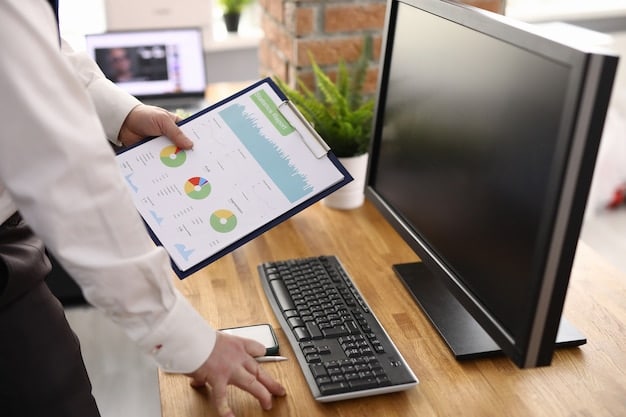Implement a Performance Management System: Practical Solutions for Your Business

Implementing a performance management system involves setting clear goals, providing regular feedback, and evaluating employee performance consistently to drive business success and improve individual growth.
Are you looking to boost your business’s performance and employee engagement? Implementing a robust performance management system is the key. This article provides practical solutions to help you set up a system that works for your US-based business, driving growth and improving employee satisfaction.
Understanding the Basics of Performance Management
Before diving into implementation, it’s crucial to understand what performance management entails. It’s more than just annual reviews; it’s a continuous process that involves setting expectations, providing feedback, and assessing performance to drive employee and organizational success.
A well-designed system ensures that employees understand their roles, receive regular feedback, and have opportunities for growth. Let’s explore some core components.
Key Components of a Performance Management System
Understanding the essential elements is the first step in building a successful system. These components work together to create a framework for continuous improvement.
- Goal Setting: Establishing clear, measurable, achievable, relevant, and time-bound (SMART) goals.
- Feedback: Providing regular, constructive feedback to help employees understand their strengths and areas for improvement.
- Performance Appraisals: Conducting formal reviews to assess overall performance and plan for future development.
- Development Planning: Creating opportunities for employees to enhance their skills and grow within the organization.
These components are the building blocks of a system that fosters growth, accountability, and alignment with business objectives.
Step-by-Step Guide to Implementing a Performance Management System
Implementing a performance management system can seem daunting. However, breaking it down into manageable steps makes the process straightforward and effective. Here’s a step-by-step guide tailored for US businesses.
Follow these steps to create a system that aligns with your business goals and enhances employee performance.
Step 1: Define Clear Goals and Objectives
Start by defining what you want to achieve with your performance management system. Align these goals with your overall business strategy and ensure they are measurable.
What specific outcomes do you expect from your employees and your system? Clear goals provide a roadmap for success.
Step 2: Design Your Performance Management Process
Next, outline the specific steps of your performance management process. This includes defining review cycles, feedback mechanisms, and documentation procedures. Consider using performance management software to streamline the process.
A structured process ensures consistency and fairness across the organization.
Choosing the Right Performance Management Software
Selecting the right software is critical for managing performance efficiently. There are numerous options available, each with unique features and benefits. Here’s what to consider when making your choice.
Consider your business needs and budget when evaluating different software solutions. The right tool can significantly enhance the effectiveness of your system.

Key Features to Look For
When evaluating software, prioritize features that align with your goals and simplify the management process.
- Goal Setting: The ability to set, track, and align employee goals with organizational objectives.
- Feedback Tools: Features for providing and receiving continuous feedback, including 360-degree reviews.
- Performance Tracking: Real-time tracking of employee performance metrics and progress toward goals.
These features can help automate and streamline your performance management tasks.
Training Managers and Employees on the New System
A successful implementation requires buy-in from both managers and employees. Training is essential to ensure everyone understands the system and their roles within it.
Investing in training can improve adoption rates and ensure the system is used effectively.
Training for Managers
Managers need to understand how to set goals, provide feedback, conduct performance reviews, and coach employees. Training should focus on developing these skills.
Equip your managers with the tools they need to support and develop their teams.
Training for Employees
Employees should understand how the system works, how their performance will be evaluated, and how they can use the system to improve their skills and advance their careers.
Empower your employees to take ownership of their performance and development.
Providing Ongoing Feedback and Support
Performance management is not a one-time event; it’s an ongoing process. Providing regular feedback and support is crucial for continuous improvement.
Continuous feedback ensures employees stay on track and have opportunities to learn and grow.

The Importance of Regular Check-Ins
Regular check-ins provide opportunities for managers to discuss progress, address challenges, and offer guidance. These meetings should be constructive and focused on helping employees succeed.
Frequent check-ins build trust and enhance communication between managers and employees.
Constructive Feedback Techniques
Feedback should be specific, timely, and focused on behavior rather than personality. Use the SBI (Situation-Behavior-Impact) model to provide clear and actionable feedback.
Effective feedback drives positive change and improves performance over time.
Measuring the Success of Your Performance Management System
To ensure your performance management system is effective, it’s important to measure its impact. Establish key performance indicators (KPIs) to track progress and identify areas for improvement.
Measuring success helps you refine your system and maximize its benefits.
Key Performance Indicators (KPIs) to Monitor
Identify specific metrics that align with your goals and track them regularly.
- Employee Engagement: Measure employee satisfaction and motivation levels.
- Performance Improvement: Track improvements in individual and team performance.
- Goal Achievement: Monitor the percentage of goals achieved across the organization.
Regularly review these KPIs to assess the effectiveness of your system.
| Key Point | Brief Description |
|---|---|
| 🎯 Goal Setting | Establish SMART goals aligned with business strategy. |
| 🗣️ Feedback | Provide regular, constructive feedback for growth. |
| ⚙️ Software | Choose software with features like goal tracking. |
| 📈 KPIs | Monitor engagement and achievement. |
Frequently Asked Questions (FAQ)
▼
A performance management system is a process for setting goals, providing feedback, and evaluating employee performance to improve individual and organizational effectiveness.
▼
It ensures employees understand their roles, receive regular feedback, and have opportunities for growth, leading to higher engagement and productivity.
▼
While annual reviews are common, more frequent feedback and check-ins (e.g., quarterly or monthly) can be more effective for continuous improvement.
▼
SMART goals are Specific, Measurable, Achievable, Relevant, and Time-bound, ensuring they are clear and actionable for employees.
▼
Address it promptly with specific feedback, a performance improvement plan, and regular check-ins to support the employee in meeting expectations.
Conclusion
Implementing a performance management system in your US-based business requires careful planning, effective communication, and ongoing support. By following these practical solutions, you can create a system that drives performance, enhances employee engagement, and contributes to your overall business success.





